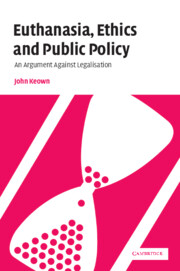Book contents
- Frontmatter
- Contents
- Preface
- Foreword
- Acknowledgments
- Table of cases
- List of abbreviations
- Introduction
- PART I Definitions
- PART II The ethical debate: human life, autonomy, legal hypocrisy, and the slippery slope
- PART III The Dutch experience: controlling VAE? condoning NVAE?
- 8 The guidelines
- 9 The first Survey: the incidence of ‘euthanasia’
- 10 Breach of the guidelines
- 11 The slide towards NVAE
- 12 The second Survey
- 13 The Dutch in denial?
- PART IV Australia and the United States
- PART V Expert opinion
- PART VI Passive euthanasia: withholding/withdrawing treatment and tube-feeding with intent to kill
- Conclusions
- Afterword
- Bibliography
- Index
8 - The guidelines
Published online by Cambridge University Press: 20 July 2009
- Frontmatter
- Contents
- Preface
- Foreword
- Acknowledgments
- Table of cases
- List of abbreviations
- Introduction
- PART I Definitions
- PART II The ethical debate: human life, autonomy, legal hypocrisy, and the slippery slope
- PART III The Dutch experience: controlling VAE? condoning NVAE?
- 8 The guidelines
- 9 The first Survey: the incidence of ‘euthanasia’
- 10 Breach of the guidelines
- 11 The slide towards NVAE
- 12 The second Survey
- 13 The Dutch in denial?
- PART IV Australia and the United States
- PART V Expert opinion
- PART VI Passive euthanasia: withholding/withdrawing treatment and tube-feeding with intent to kill
- Conclusions
- Afterword
- Bibliography
- Index
Summary
The Dutch law
The Netherlands is the only country in which VAE is legally permitted and widely practised. Although it is a specific offence under the Dutch Penal Code to kill another person at his request, the Dutch Supreme Court held in 1984 that a doctor who ends the life of a patient may in certain circumstances successfully invoke the defence of ‘necessity’, also contained in the Code. This defence operates to justify (though in some other jurisdictions it serves only to excuse) the actions of a person who has broken the law, but who has acted reasonably and proportionately in doing so to secure a higher value recognised by the law. A simple example would be the action of pulling a jaywalker from the path of an oncoming car. The law, upholding the values of human autonomy and bodily integrity, generally prohibits touching others without their consent. But it condones the action of one who pulls a jaywalker to safety even though there is no time to seek his consent.
A few months before the landmark case in 1984, the Royal Dutch Medical Association (KNMG) published guidelines for VAE, guidelines which were considered by the Supreme Court in arriving at its decision. Since that time the lives of tens of thousands of Dutch patients have been actively and intentionally shortened by their doctors. A requirement central to both the legal and medical guidelines has been the free and explicit request of the patient.
- Type
- Chapter
- Information
- Euthanasia, Ethics and Public PolicyAn Argument Against Legalisation, pp. 83 - 90Publisher: Cambridge University PressPrint publication year: 2002

